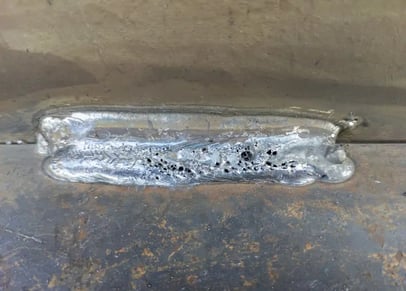Deciphering the Secret of Porosity in Welding: Tips for Lessening Flaws and Optimizing Quality
In the intricate globe of welding, porosity stays a consistent obstacle that can considerably influence the quality and honesty of bonded joints. As we delve into the midsts of porosity in welding, discovering the secrets to its prevention and control will be critical for experts seeking to master the art of high-grade weldments.
Understanding Porosity in Welding
Porosity in welding, a typical concern run into by welders, refers to the visibility of gas pockets or spaces in the bonded material, which can endanger the stability and top quality of the weld. These gas pockets are normally caught throughout the welding process as a result of numerous variables such as incorrect protecting gas, contaminated base materials, or inaccurate welding specifications. The formation of porosity can deteriorate the weld, making it at risk to fracturing and rust, eventually leading to structural failures.
Understanding the origin of porosity is important for welders to successfully prevent its event. By recognizing the significance of keeping correct gas securing, making sure the tidiness of base materials, and enhancing welding settings, welders can significantly lower the likelihood of porosity formation. In addition, utilizing methods like pre-heating the base material, using appropriate welding strategies, and carrying out thorough assessments post-welding can further assist in lessening porosity flaws. In general, a thorough understanding of porosity in welding is vital for welders to create top quality and long lasting welds.

Common Causes of Porosity
When checking welding processes for possible high quality concerns, recognizing the common causes of porosity is crucial for keeping weld integrity and stopping structural failings. Porosity, defined by the presence of dental caries or gaps in the weld metal, can considerably compromise the mechanical residential or commercial properties of a welded joint. One common root cause of porosity is incorrect shielding gas insurance coverage. Inadequate securing gas flow prices or inappropriate gas combinations can bring about climatic contamination, resulting in porosity development.
An additional common root cause of porosity is the presence of wetness and pollutants on the surface area of the base steel or filler product. When welding materials are not correctly cleaned or are exposed to high degrees of humidity, the evaporation of these contaminants throughout welding can create gaps within the weld bead. In addition, welding at incorrect specifications, such as excessively high traveling speeds or currents, can generate extreme turbulence in the weld pool, capturing gases and creating porosity. By resolving these common reasons with proper gas securing, product preparation, and adherence to ideal welding parameters, welders can minimize porosity and enhance the quality of their welds.
Strategies for Porosity Avoidance
Carrying out reliable preventive steps is essential in minimizing the occurrence of porosity in welding processes. One technique for porosity prevention is guaranteeing proper cleaning of the base metal before welding. Impurities such as oil, oil, rust, and paint can lead to porosity, so comprehensive cleansing making use of suitable solvents or mechanical methods is essential.

Using advice high-grade filler materials and protecting gases that are appropriate for the base metal and welding process can significantly minimize the threat of porosity. Furthermore, preserving appropriate welding specifications, such as voltage, present, travel speed, and gas flow rate, is essential for porosity avoidance.
In addition, using appropriate welding strategies, such as maintaining a consistent travel rate, electrode angle, and arc length, can assist stop porosity (What is Porosity). Ample training of welders to guarantee they follow best practices and top quality control treatments is also vital in decreasing porosity flaws in welding

Finest Practices for Top Quality Welds
One key method is keeping correct tidiness in the welding area. Extensively cleaning up the work surface and surrounding location before welding can aid minimize these issues.
One more ideal practice is to thoroughly select the proper welding parameters for the particular products being signed up check my source with. Proper specification option ensures optimum weld infiltration, blend, and overall high quality. Using high-grade welding consumables, such as electrodes and filler metals, can considerably impact the last weld quality.
Significance of Porosity Control
Porosity control plays a crucial function in guaranteeing the integrity and high quality of welding joints. Porosity, characterized by the presence of dental caries or voids within the weld metal, can considerably jeopardize the mechanical residential properties and structural honesty of the weld. Excessive porosity weakens the weld, making it a lot more prone to splitting, rust, and overall failing under functional lots.
Effective porosity control is vital for maintaining the preferred mechanical buildings, such as stamina, ductility, and toughness, of the welded joint. What is Porosity. By lessening porosity, welders can enhance the total quality and integrity of the weld, ensuring that it meets the performance demands of the intended application
Moreover, porosity control is vital for accomplishing the desired aesthetic look of the weld. Extreme porosity not only deteriorates the weld however also detracts from its visual allure, which can be critical in industries where looks are crucial. Correct porosity control methods, such as utilizing the appropriate securing gas, controlling the welding parameters, and guaranteeing appropriate tidiness of the base materials, are necessary for generating premium welds with marginal issues.

Conclusion
To conclude, porosity in welding is an usual defect that can compromise the top quality of the weld. By understanding the root causes of porosity and implementing correct prevention methods, welders can reduce issues and achieve higher top quality welds. It is see this page important to control porosity in welding to guarantee the integrity and strength of the last product. Applying ideal methods for porosity control is essential for accomplishing optimal welding results.